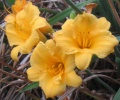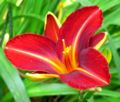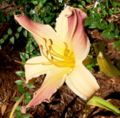Lily
| Lily |
|---|

|
| Scientific Classification |
|
| Species |
About 100 species, including:
|
This genus Lilium, in the family Liliaceae, contains the true lilies, of which there are about 100 species. Some people confuse the lily for other close relatives. Correct identification can be done by looking at the bulb. The bulb won't have an outer coating, and they never are dormant.
Anatomy
Lilies are usually herds and leafy stemmed. Lilies mostly form as tunic-less scaly bulbs. Sometimes in the North American species of lilies the base can form into rhizomes. In the rhizomes many bulbs can be found. Some form stoloned (an aeaial shoot that can produce roots and new offshoots from the same plant) and others will form bulbs by or at the surface of the soil.
Most lilies form stem foots; this will allow bulbs to grow naturally at the same depth as the soil. But each year new stems will make new roots on top of the bulb as the bulb comes to the surface (these roots are different then the ones on the bottom of the bulb).
They have six-petalled flowers. Most of the time they have a fragrance. The lily comes in many colors: white, yellow orange, pink, red, purple, bronze, and some are almost black. Lilies have special marks on their petals like spots, brush strokes, and picotees.
Reproduction

Lilies reproduce sexually like all flowering plants. They have a long blooming period, which makes them attractive for ornamental gardening. They will continue to grow through the winter (perennial).
Ecology
Lilies are showy plants, large, and great for gardens. They are a food source to larvae and some Lepidoptera. There are bitter bulbs, but the non-bitter ones are sold in China as health food. They are mostly eaten in the summer and are dried.
Lilies come from the northern region. Lilies can be found in many places all over the world. Some of the places they are found are in Europe, the United States, Canada, and Asia to Japan.
They have adapted to woodlands and grassland habitats. Some can make it in the marshlands, but for the most part, they like the acidic or lime-free soils.
Gallery
Daylily (Hemerocallis fulva)
References
External links
- Lilium Ohio State University






